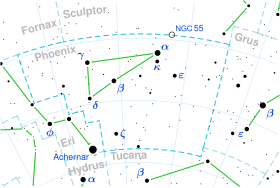Gamma Phoenicis
| Observation data Epoch J2000 Equinox J2000 | |
|---|---|
| Constellation | Phoenix |
| Right ascension | 01h 28m 21.92727s[1] |
| Declination | −43° 19′ 05.6502″[1] |
| Apparent magnitude (V) | 3.41[2] |
| Characteristics | |
| Spectral type | M0III[3] |
| U−B color index | +1.85[4] |
| B−V color index | +1.57[4] |
| Variable type | Lb?[5] + β Lyr[6][7] |
| Astrometry | |
| Radial velocity (Rv) | +25.80[8] km/s |
| Proper motion (μ) | RA: −18.06[1] mas/yr Dec.: −208.63[1] mas/yr |
| Parallax (π) | 13.96 ± 0.34 mas[1] |
| Distance | 234 ± 6 ly (72 ± 2 pc) |
| Absolute magnitude (MV) | −0.86[2] |
| Orbit[9] | |
| Period (P) | 193.9 d |
| Semi-major axis (a) | 0.057[10][note 1]" (0.30 au) |
| Eccentricity (e) | 0.0301 |
| Inclination (i) | 46.3° |
| Longitude of the node (Ω) | 340.2[10]° |
| Periastron epoch (T) | 2453670.987 |
| Argument of periastron (ω) (secondary) | 136.8° |
| Semi-amplitude (K1) (primary) | −15.845 km/s |
| Details[6] | |
| Primary | |
| Mass | 1.3 M☉ |
| Radius | 50 – 55 R☉ |
| Luminosity | 562 L☉ |
| Temperature | 3,802 K |
| secondary | |
| Mass | 0.6 M☉ |
| Other designations | |
| Database references | |
| SIMBAD | data |
Gamma Phoenicis is a star system in the constellation Phoenix, located around 71.63 parsecs (233.6 ly) distant.[1]

γ Phoenicis is a spectroscopic binary and a small amplitude variable star. The star system shows regular variations in brightness that were reported as a 97.5 day period in the Hipparcos catalogue,[1] but have since been ascribed to a 194.1-day orbital period with primary and secondary minima.[11] Although the light curve appears to show eclipses, the high orbital inclination suggests the variations are due to ellipsoidal stars as they rotate in their orbit.[6] γ Phoenicis is listed in the General Catalogue of Variable Stars as a possible slow irregular variable with a range from 3.39 to 3.49, the same as reported for the eclipses or ellipsoidal variations.[5]
Only the primary star in the γ Phoenicis system is visible. The second is inferred solely from variations in the radial velocity of the primary star. The primary is a red giant of spectral type M0III, a star that has used up its core hydrogen, then expanded and cooled as it burns a shell of hydrogen around an inert helium core. The two stars are estimated to have masses of 1.3 M☉ and 0.6 M☉ respectively. The primary is over five hundred times more luminous than the sun. The system shows signs of hot coronal activity, although the primary star is too cool for this. It may originate on the secondary, possibly as material is accreted from the cool giant primary.[6]
Notes
[edit]- ^ This is the photocentric semi-major axis, from the motion shown by the observed "star" relative to distant objects, and in practice relative to the barycentre. This is always smaller than the orbital semi-major axis, dramatically smaller when the primary star is much more massive than the secondary or when it is not much brighter.
References
[edit]- ^ a b c d e f g Van Leeuwen, F. (2007). "Validation of the new Hipparcos reduction". Astronomy and Astrophysics. 474 (2): 653–664. arXiv:0708.1752. Bibcode:2007A&A...474..653V. doi:10.1051/0004-6361:20078357. S2CID 18759600. Vizier catalog entry
- ^ a b Anderson, E.; Francis, Ch. (2012). "XHIP: An extended hipparcos compilation". Astronomy Letters. 38 (5): 331. arXiv:1108.4971. Bibcode:2012AstL...38..331A. doi:10.1134/S1063773712050015. S2CID 119257644. Vizier catalog entry
- ^ Keenan, P.; McNeil, R. (October 1989). "The Perkins catalog of revised MK types for the cooler stars". Astrophysical Journal Supplement Series. 71: 245–266. Bibcode:1989ApJS...71..245K. doi:10.1086/191373.
- ^ a b Mermilliod, J. C. (2006). "VizieR Online Data Catalog: Homogeneous Means in the UBV System (Mermilliod 1991)". VizieR On-line Data Catalog: II/168. Originally Published in: Institut d'Astronomie. 2168. Bibcode:2006yCat.2168....0M.Vizier catalog entry
- ^ a b Samus, N. N.; Durlevich, O. V.; et al. (2009). "VizieR Online Data Catalog: General Catalogue of Variable Stars (Samus+ 2007-2013)". VizieR On-line Data Catalog: B/GCVS. Originally Published in: 2009yCat....102025S. 1. Bibcode:2009yCat....102025S.
- ^ a b c d Jorissen, A.; Frankowski, A.; Famaey, B.; Van Eck, S. (2009). "Spectroscopic binaries among Hipparcos M giants. III. The eccentricity - period diagram and mass-transfer signatures". Astronomy and Astrophysics. 498 (2): 489. arXiv:0901.0938. Bibcode:2009A&A...498..489J. doi:10.1051/0004-6361/200810703. S2CID 2754939.
- ^ "Gam Phe". The International Variable Star Index. AAVSO – American Association of Variable Star Observers. Retrieved 29 January 2018.
- ^ Evans, D. S. (1967). "The Revision of the General Catalogue of Radial Velocities". Determination of Radial Velocities and Their Applications. 30: 57. Bibcode:1967IAUS...30...57E.
- ^ Komonjinda, Siramas; Hearnshaw, John B.; Ramm, David J. (2011). "Orbital solutions for six spectroscopic binaries with circular or nearly circular orbits". Monthly Notices of the Royal Astronomical Society. 410 (3): 1761. Bibcode:2011MNRAS.410.1761K. doi:10.1111/j.1365-2966.2010.17558.x.
- ^ a b Jancart, S.; Jorissen, A.; Babusiaux, C.; Pourbaix, D. (2005). "Astrometric orbits of SB9 stars". Astronomy and Astrophysics. 442 (1): 365–380. arXiv:astro-ph/0507695. Bibcode:2005A&A...442..365J. doi:10.1051/0004-6361:20053003. S2CID 15123997.
- ^ a b Otero, Sebastián A. (October 2007). "New Elements for 54 Eclipsing Binaries". Open European Journal on Variable Stars. 72 (1): 1–19. Bibcode:2007OEJV...72....1O.

